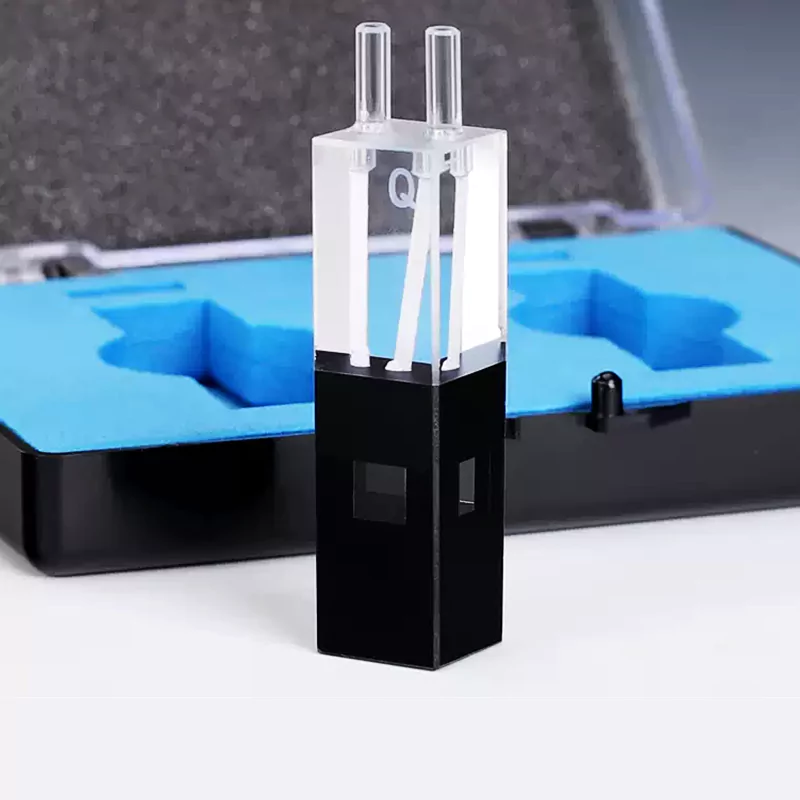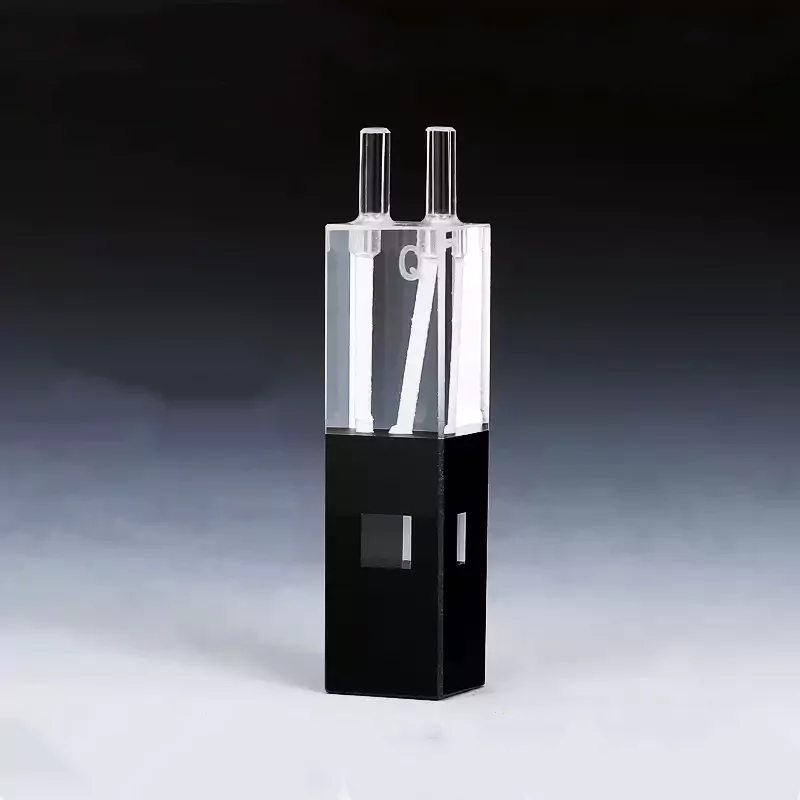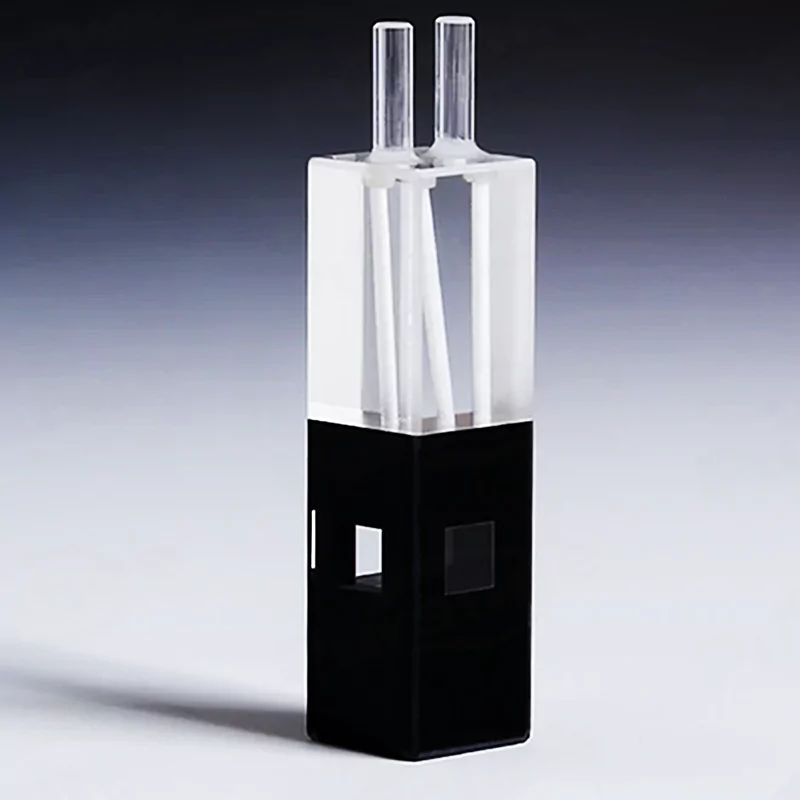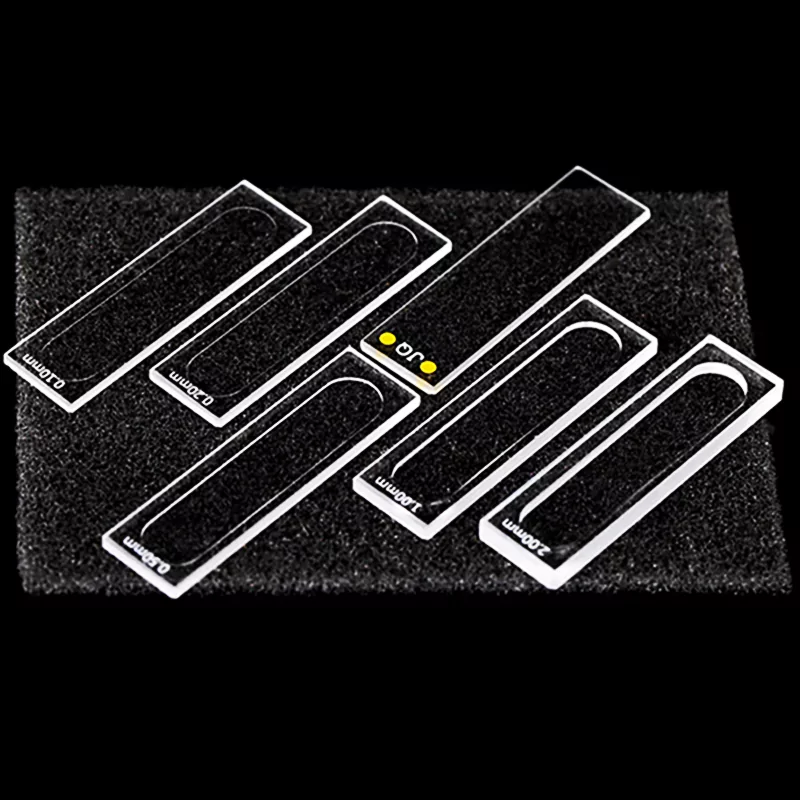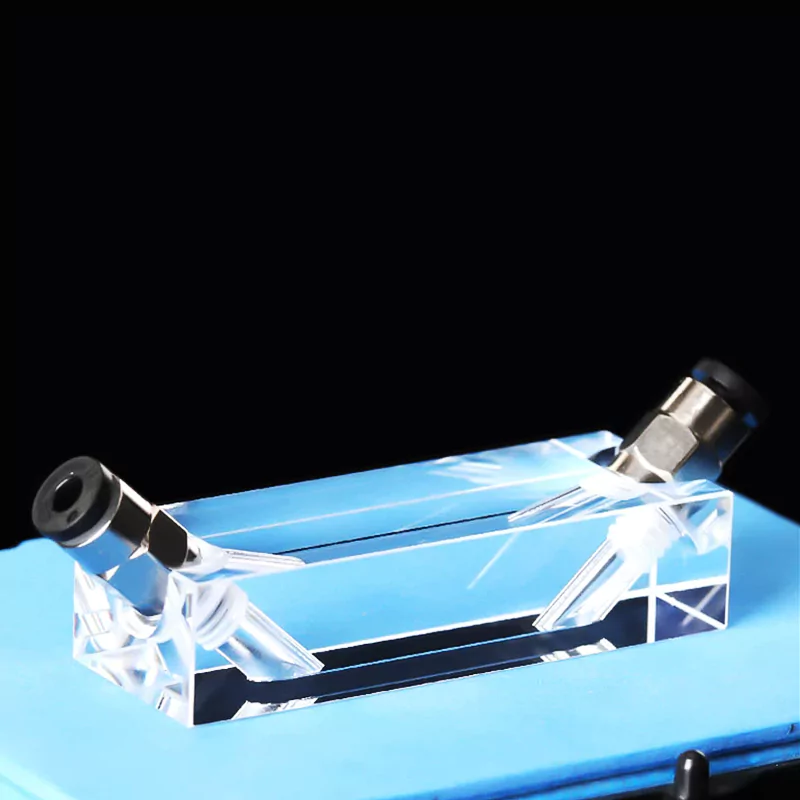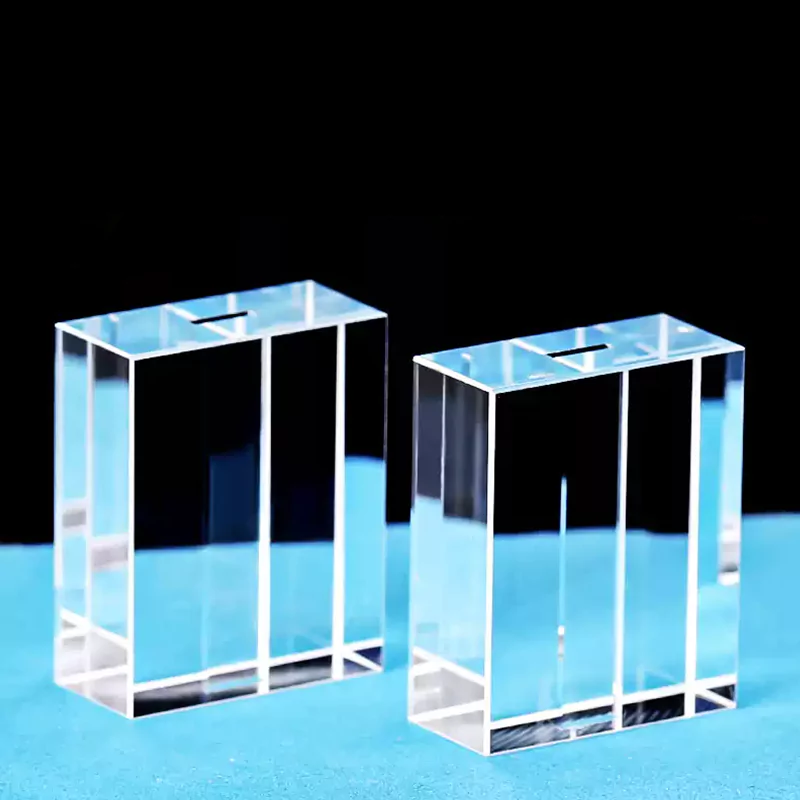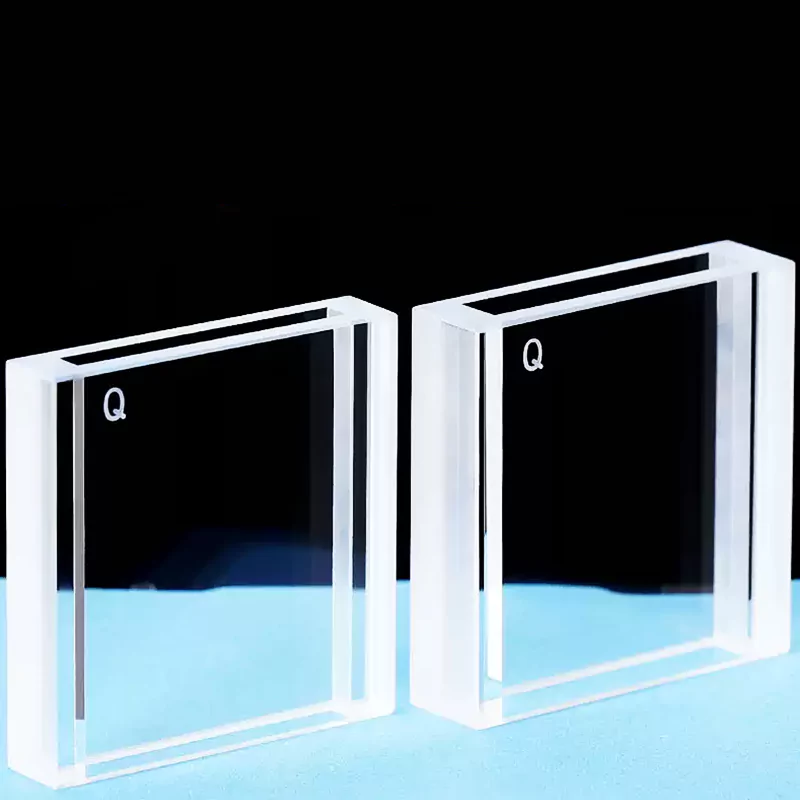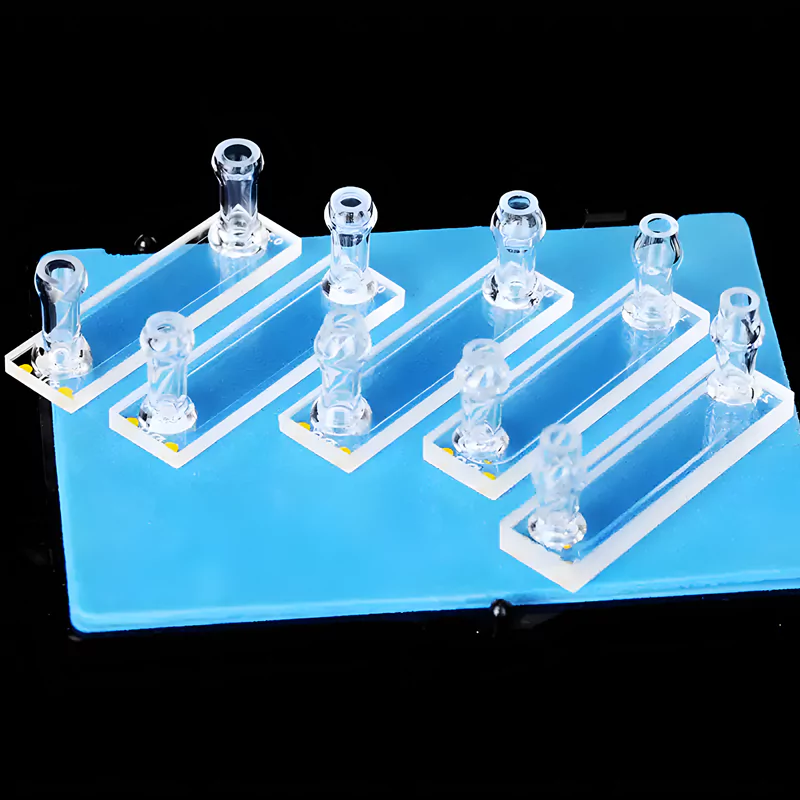- Home
- /
- Types
- /
- Quartz Cuvette
- /
- Quartz Flow-Through Cuvette
- /
- Enhanced Sensitivity Black Wall...
Enhanced Sensitivity Black Wall Fluorescence Flow Cuvette with Glass Tubes for Chromatography -TOQUARTZ®
Features of Black Wall Fluorescence Flow Cuvette with Glass Tube
TOQUARTZ® Black Wall Fluorescence Flow Cuvette with Glass Tubes combines advanced optical properties with precise engineering to deliver superior performance for fluorescence analysis applications. Each unit is manufactured with attention to detail to ensure consistent quality and reliable results.
Light Transmission
Provides excellent transmission across 190-2500nm wavelength range, ensuring accurate and reliable measurement results. The high-purity quartz material enables transparency in both UV and visible light regions.
Black Wall Design
Black walls effectively absorb scattered light, minimizing stray light interference and enhancing measurement sensitivity. This design is particularly beneficial for low-concentration fluorescence analysis.
High-Purity Quartz
Manufactured from high-purity quartz material (up to 99.995% purity) ensuring consistent quality and stability. The material properties provide excellent resistance to chemical corrosion and thermal shock.
Glass Tube Connections
Integrated glass tube connections facilitate easy integration with existing laboratory setups. These connections ensure secure, leak-free operation for continuous flow applications.
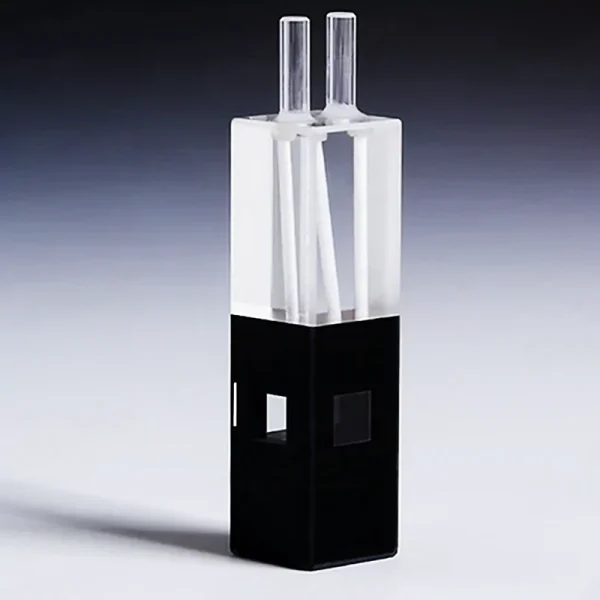
- SiO2 Purity ≥99.98%, up to 99.995%
- Chemical Resistance to Harsh Reagents
- Customization Services Available
Technical Specifications & Dimensions of Black Wall Fluorescence Flow Cuvette with Glass Tube
Technical Specifications
| Property | Value | Test Method |
| 1. Physical Properties | ||
| Maximum Operating Temperature | 1100°C | Short-term exposure |
| Thermal Expansion Coefficient | 5.5 × 10-7/℃ | 20-320°C range |
| 2. Chemical Properties | ||
| Material Purity | Up to 99.995% | High-purity quartz |
| Chemical Resistance | Excellent | Resistant to most acids and organic solvents |
| Hydrolytic Resistance | Class 1 | ISO 719 standard |
| Water Absorption | < 0.01% | At 20℃ |
| OH Content | < 30 ppm | For standard grade |
| 3. Optical Properties | ||
| Transmission Range | 190-2500 nm | Covers UV through NIR |
| UV Cutoff Wavelength | 185 nm | 10 mm path length |
| Refractive Index | 1.458 at 546.1 nm | At 20°C |
| Stray Light Absorption | > 99% | By black walls |
| Optical Homogeneity | < 5 × 10-6 | High grade optical quality |
| Optical Finish | < 0.2 nm RMS | Optical windows |
Size Chart

| Model | Description | Path Length | Volume | Outline Dimension |
| AT-BSM-8030 | 250μl Black Wall Quartz Fluorescence Flow Cuvette with Glass Tubes | 10mm | 250μl | 12.5×12.5x45mm |
Solving Analytical Challenges with TOQUARTZ® Black Wall Fluorescence Flow Cuvette with Glass Tube
Post-Column Fluorescence in HPLC/UPLC (trace organics & drug impurities)
Key Advantages
-
Stray-Light Rejection (Black Walls)
Baseline ripple cut by ~40% (0.30→0.18 mVpp at 365 nm, 10 mm path, 0.30 mL/min), improving LOD/LOQ without changing optics. -
Ultra-Low Dispersion Flow Cell
Internal hold-up ≤10 µL; added volume per glass port <0.8 µL, limiting UPLC peak broadening to <5% at FWHM (0.30 mL/min). -
Carryover Control on Solvent Swaps
Super-smooth swept channel yields <0.05% carryover after 2× system-volume rinse when switching ACN/H₂O↔MeOH/H₂O.
TOQUARTZ® solution
A pharma QC lab quantified a genotoxic impurity (target 0.1 ppm) post-column with FL detection at 365/455 nm. Switching to the TOQUARTZ black-walled flow cuvette reduced baseline noise from 0.26 to 0.15 mV RMS and peak width increased only 3% versus 11% with their prior cell. LOQ improved 2.6× (0.078→0.030 ppm) and carryover fell to 0.03% after a 2-minute rinse. Batch release time dropped by 18% due to fewer repeat injections.
Flow Injection Analysis (FIA) & Online Water-Quality Fluorometry
Key Advantages
-
Turbidity-Robust Signal
Black-wall design raises S/N by 35–45% at 30–100 NTU versus clear-wall cells during fluorescein/rhodamine WT assays. -
Anti-Bubble Through-Ports
Straight glass tubes and streamlined chamber purge bubbles in <0.5 s at 1.0 mL/min, eliminating spike artifacts. -
Field-Swap & CIP Friendly
Tube-slip ports enable <60 s cell swaps; 5-minute in-place rinse (0.5% NaOCl or DI) restores baseline within ±0.2 mV.
TOQUARTZ® solution
A municipal plant running rhodamine-WT tracer FIA experienced false spikes during high-NTU events. After adopting the TOQUARTZ black-walled flow cuvette, spike incidents fell by 83% and 90-day uptime rose from 97.1% to 99.5%. MDL improved from 0.08 to 0.03 µg/L at 0.8 mL/min. Weekly 5-minute CIP kept drift within ±0.5% with no unscheduled maintenance.
Bioprocess PAT Bypass for Real-Time NADH/Tryptophan Fluorescence
Key Advantages
-
Scatter Suppression in Turbid Broth
Black walls reduce side-scatter background by ~45% at OD600 = 5, stabilizing NADH emission. -
Fast-Response Bypass Volume
Hold-up ≈40 µL gives <1 s transport lag at 2.5 mL/min, capturing feed-induced transients. -
SIP/CIP Survivability
Glass-tube/walled assembly verified for 50 cycles at 121 °C/30 min with <2% signal drift post-cycle.
TOQUARTZ® solution
A biotech fermenter (E. coli fed-batch) monitored NADH online via a sterile bypass. With the TOQUARTZ black-walled cuvette, baseline wander during high cell density fell 48% and correlation to offline OD600 improved (R² 0.76→0.93). The faster <1 s lag enabled feed-pump PID tuning that cut glucose overshoot by 22%. Across 12 weeks and 18 SIP cycles, no fouling-related recalibration was required.
TOQUARTZ® Customization Services for Black Wall Fluorescence Flow Cuvette with Glass Tube
Dimensional Customization
Tailored geometries for Black Wall Fluorescence Flow Cuvette with Glass Tubes.
-
Optical Path:
Select path length to balance sensitivity against chromatographic peak width. -
Internal Volume:
Optimize hold up volume to minimize dispersion and sample carryover. -
Window Geometry:
Define aperture size and position for detector alignment and throughput. -
Channel Profile:
Choose channel cross section to reduce recirculation and bubble trapping. -
Tolerancing Strategy:
Specify critical tolerances only where they affect optical repeatability.
Connection Adaptations
Interface choices suit chromatographs, FIA manifolds, and bioprocess bypasses on Black Wall Fluorescence Flow Cuvette with Glass Tubes.
-
Glass Tube Ports:
Straight through ports minimize dead volume and simplify bubble purging. -
Threaded Adapters:
Optional threaded fittings enable robust seals and repeatable instrument docking. -
Quick Disconnects:
Support rapid cell swaps during maintenance without recalibrating optical alignment. -
Sensor Integration:
Ports accommodate inline temperature or pressure sensors for process control. -
Tubing Compatibility:
Compatible with PTFE PEEK and silicone tubing used in laboratories.
Material Specifications
Material options target optical stability, chemical resistance, and sanitation for Black Wall Fluorescence Flow Cuvette with Glass Tubes.
-
Quartz Purity:
Select spectral grade aligned to fluorescence wavelengths and background suppression. -
Black Coating:
Define coating thickness and finish for maximum stray light rejection. -
Surface Finish:
Specify interior polish to lower adsorption and ease cleaning validation. -
Seal Materials:
Choose elastomers compatible with solvents and sanitation regimes without swelling. -
Traceability Docs:
Request certificates and lot traceability supporting regulated or audited environments.
Usage and Care Guidelines
Handling & Installation
- Always handle the flow cuvette by the sides, avoiding contact with the optical windows to prevent fingerprints and contamination.
- When connecting tubing, apply gentle pressure evenly to prevent stress on the glass connections. Use appropriate fittings that match the glass tube diameter.
- Ensure the flow direction matches the indicated arrows on the cuvette (if applicable) for optimal fluid dynamics.
- When mounting in an instrument, use the appropriate holders designed for flow cells to prevent mechanical stress.
- For initial installation, flush the flow cell with an appropriate solvent (typically the mobile phase or buffer to be used) before analytical use.
Cleaning & Maintenance
- Regular cleaning: Flush with appropriate solvent after each use to prevent sample residue buildup.
- For persistent contaminants, flush with a 10% solution of laboratory-grade detergent, followed by thorough rinsing with deionized water.
- For optical window cleaning, use spectroscopic-grade solvents (methanol, acetone) and lint-free wipes designed for optical surfaces.
- Avoid aggressive acids or bases that could attack the seals or connection points. If in doubt, consult our compatibility guide.
- When not in use, store the flow cell filled with clean solvent and with end caps in place to prevent dust contamination and drying of residues.
Troubleshooting Common Issues
| Issue | Possible Cause | Solution |
| Leaking connections | Improper fitting or overtightened connection | Replace fittings, ensure proper size, apply even pressure |
| Decreased sensitivity | Window contamination or scratches | Clean windows with optical solvent, replace if scratched |
| Air bubbles in flow path | Improper degassing or connection issue | Increase flow rate temporarily, check for loose fittings |
| Baseline drift | Temperature fluctuation or residual contamination | Stabilize temperature, perform thorough cleaning |
Need Custom Black Wall Fluorescence Flow Cuvettes?
Contact us today for a free consultation.
Why Partner with TOQUARTZ
Direct Factory Advantage
As a direct manufacturer, we can cut out the numerous intermediate links.
Engineering Expertise
Technical team guides clients from material selection to design optimization, translating specs into deliverables.
Flexible Manufacturing
Handling standard & custom orders via small-batch expertise and prototyping rigor to meet urgent deadlines.
Quality
Assurance
Pre-shipment 3-step validation:
1. dimensional accuracy,
2. material purity ,
3. performance thresholds
Global Supply Chain
Reliable global logistics to industrial hubs (DE/US/JP/KR priority) with trackable milestones.
Releted Products
As a specialized manufacturer with direct factory capabilities, TOQUARTZ provides both standard and custom quartz solutions with engineering support throughout the specification and implementation process.
FAQ
Q: How does the Black Wall Fluorescence Flow Cuvette with Glass Tubes improve fluorescence sensitivity?
A: The black wall design of the Black Wall Fluorescence Flow Cuvette with Glass Tubes minimizes stray light and internal reflections, significantly enhancing fluorescence signal-to-noise ratios. This improves sensitivity, particularly in low-level fluorescence measurements. The black walls ensure that the measurement is not compromised by unwanted background light.
Q: Can the Black Wall Fluorescence Flow Cuvette with Glass Tubes be used for high-throughput chromatography?
A: Yes, the Black Wall Fluorescence Flow Cuvette with Glass Tubes is ideal for HPLC/UPLC applications, especially in high-throughput environments. Its flow-through design ensures minimal sample dispersion, preserving chromatographic peak integrity. This results in more accurate and reproducible fluorescence measurements for trace impurities or metabolites.
Q: How does the Black Wall Fluorescence Flow Cuvette with Glass Tubes handle turbid samples in fluorescence measurements?
A: The black wall minimizes scattered light from turbid samples, ensuring that the fluorescence signal remains clear. This is especially important when working with samples containing suspended particles, as it prevents false readings caused by scatter. It maintains accurate measurements even in complex matrices.
Q: Is the Black Wall Fluorescence Flow Cuvette with Glass Tubes suitable for low-concentration fluorescence detection?
A: Yes, the Black Wall Fluorescence Flow Cuvette with Glass Tubes excels in low-concentration fluorescence detection. Its superior light absorption and minimized stray light enhance the detection of trace amounts of fluorescence signals, providing high sensitivity even for dilute samples.
Q: What role does the black wall design of the Black Wall Fluorescence Flow Cuvette with Glass Tubes play in reducing background noise?
A: The black wall design effectively absorbs stray light, preventing it from interfering with the fluorescence signal. This is critical in reducing background noise, especially in applications where precision is essential. It ensures that the detected signal is primarily from the sample, improving data quality.
Contact our engineering team for technical consultation and pricing. We’ll help you select the optimal specifications for your application requirements.

